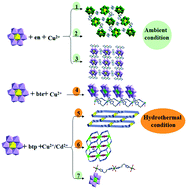A series of 0D to 3D Anderson-type polyoxometalate-based compounds obtained under ambient and hydrothermal conditions†
Abstract
Through using flexible ethanediamine (en) and bis(triazole) ligands, a series of Anderson POM-based compounds, [{CuII2(en)4}{Al(OH)6Mo6O18}]2·[{CuII(en)2}{Al(OH)6Mo6O18}]2·47H2O (1), [{CuII2(en)4}{Cr(OH)6Mo6O18}]2·[{CuII(en)2}{Cr(OH)6Mo6O18}]2·47H2O (2), [{CuII5/2(en)3(μ2-OH)2}{Al(OH)6Mo6O18}]·H2O (3), [{CuII(bte)2(H2O)}{HCr(OH)6Mo6O18}]·6H2O (4), [{CuII3(btp)2(H2O)4}{Cr(OH)6Mo6O18}2]·6H2O (5), [{CuI2(btp)}{Cr(OH)6Mo6O18}{K(H2O)2}] (6) and [Cd3(btp)2(H2O)14]H3[Cr(OH)6Mo6O18]3·16H2O (7) (bte = 1,2-bis(1,2,4-triazol-1-yl)ethane and btp = 1,3-bis(1,2,4-triazol-1-yl)propane), were synthesized and structurally characterized. In isostructural compounds 1 and 2, the 2D grid-like layers and 1D metal–organic chains arrange alternately through hydrogen bonding interactions. Compound 3 has a 2D grid-like layer with Anderson anions linked by mono- and binuclear CuII clusters alternately. Compound 4 shows a 1D cycle-connecting-cycle metal–organic chain with anions hanging on one side. In compound 5, the Cr2-anions are connected by [Cu3(btp)2]6+ subunits to form a 2D layer. The Cr1-anions link adjacent layers to build a 3D framework. In 6, the anions link ladder-like Cu–btp chains to construct a 3D framework, with K ions embedding in the channels. Compound 7 exhibits a discrete structure with [Cd3(btp)2(H2O)14]6+ as a counter cation. The successful syntheses of 1–7 reveal that both the appropriate ambient and hydrothermal conditions can induce Anderson-based compounds with ease. Furthermore, we also studied the electrochemical and photocatalytic properties of the title compounds.



 Please wait while we load your content...
Please wait while we load your content...